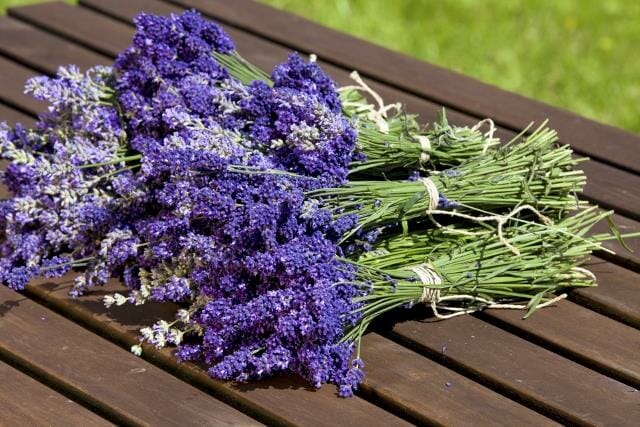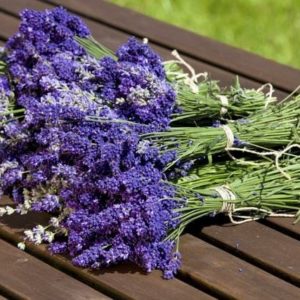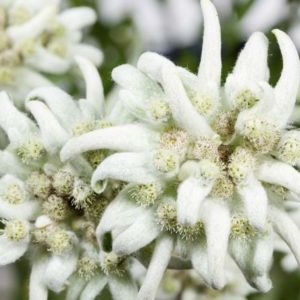
Growing and Using Lavender
Growing and Using Lavender
Dr. Leonard Perry, Extension Professor
University of Vermont
Lavender flowers can be used in cooking, although its flowers are most often used in potpourri and as sachets, and the leaves distilled for their oils. Most are familiar with lavender through cosmetic products. Herbalists consider its oil one of the most important for therapeutic uses and healing, such as wounds and burns. Lavender oil scent is used for calming, and to induce sleep. Its first documented use was by the Romans in 77 A.D. for insect bites and to repel insects.
In the landscape, this low plant is used for its gray-green to silvery leaves, or its flowers in July or August. Generally in shades of blue or purple, flowers of some selections are pink or white. Flowers contain lots of nectar, so are attractive to bees. Depending on the species and season, they may bloom from 4 to 8 weeks. Lavender is a low-care, low maintenance plant.
 Although it is a Mediterranean small shrub, termed “subshrub”, it can be grown in other climates as a tender perennial or even annual flower. Lavender (Lavandula) can grow year round in a hot and dry climate like southern California and the arid Southwest, or even arid West. Most of the 15 or so species don’t grow as well, nor are long-lived, in hot and humid climates such as the Southeast or Midwest. Exceptions for hot and humid climates are the Spanish lavender (L. stoechas), and the French or fringed lavender (L. dentata), hardy in only warmer zones (7-9) where temperatures stay above 10 degrees (F). These are often termed non-English types.
Although it is a Mediterranean small shrub, termed “subshrub”, it can be grown in other climates as a tender perennial or even annual flower. Lavender (Lavandula) can grow year round in a hot and dry climate like southern California and the arid Southwest, or even arid West. Most of the 15 or so species don’t grow as well, nor are long-lived, in hot and humid climates such as the Southeast or Midwest. Exceptions for hot and humid climates are the Spanish lavender (L. stoechas), and the French or fringed lavender (L. dentata), hardy in only warmer zones (7-9) where temperatures stay above 10 degrees (F). These are often termed non-English types.
The English lavenders (L. angustifolia) generally are listed as hardy to USDA zone 5 (-10 to -20 degrees), although sometimes they may grow into a colder zone if sufficient reliable snow cover. Otherwise, protect these lavenders in these areas by straw or evergreen branches at least 3 to 4 inches deep. In warm climates with long seasons, such as the West, these may rebloom the same year. Some of the best and most popular English cultivars (cultivated varieties) include ‘Munstead’ (early, blue-purple flowers, to about 2-feet high) and ‘Hidcote’ (dark blue flowers, to about 18-inches high). ‘Jean Davis’ is an English lavender with light pink flowers.
The third main group of lavender cultivars, the “lavandins”, are a cross of the English species and the spike or Portuguese lavender (L. latifolia). The latter grow into zone 5, but also are a great choice for hot climates. The lavandins (L. x intermedia) generally are hardy, too, often into zone 5. They are grown commercially for their increased vigor, size, and higher oil content. A couple of good ones to try are ‘Grosso’ (dark purple flowers, to about 30-inches high) and ‘Provence’ (purple flowers, more rot resistant, to about 2-feet high). ‘Edelweiss’ is a lavandin with white flowers.
Lavender can be started from seeds, but the cultivars often will not “come true” or have the same desired traits if grown from seeds, and seeds are difficult to germinate. Best is to buy lavender plants already started, and which your vendor knows are grown from cuttings. The lavandins have sterile seeds, so only can be grown from cuttings.
If moving a plant, do so in spring, and make sure to get plenty of soil around the roots. In the north, it’s best to plant in the spring so plants can establish during the summer. In hot climates, fall planting may be best. Give plenty of space, so air circulation can help reduce leaf disease. A spacing of 2- feet apart is good for most cultivars, or slightly more space for the larger lavandins.
Lavender really needs full sun, and although they will tolerate drought once established, they bloom best if not allowed to dry out. Plants do require a well-drained soil, especially through winter, and grow well in rocky or sandy soils. They prefer a neutral pH soil, so if somewhat acidic you’ll need to add lime (an Extension soil test will tell you how much to add).
Don’t overfertilize, as they perform best in lean soils. A side-dressing once a year of some compost may be sufficient, but plants don’t like an overly organic soil either. You can fertilize a couple times during summer with liquid seaweed or fish emulsion.
While we appreciate the fragrant, essential oils of lavender, pests, rabbits and deer don’t, so plants are not bothered by them. The main problem can be fungal rots from too wet soil, or too humid a climate.
 Plants will need some pruning, but only in spring after you see new growth. Only prune last year’s growth back, leaving about an inch of this less woody growth, unless plants have been left for a while and become unsightly. In this case, prune stems back by about one-third, or take out any dead or quite old stems. You can cut them back lightly, shearing for shaping, right after flowering.
Plants will need some pruning, but only in spring after you see new growth. Only prune last year’s growth back, leaving about an inch of this less woody growth, unless plants have been left for a while and become unsightly. In this case, prune stems back by about one-third, or take out any dead or quite old stems. You can cut them back lightly, shearing for shaping, right after flowering.
Lavenders generally take 3 years to reach mature size and peak yield. Harvest lavender flowers just as they are beginning to open, in the morning, as this is when they have the highest oil content and scent. Cut the long stems, spread on a screen or trays, and let dry in the sun for several days. If rainy, place in a warm, dry location with good air movement. Or, you can hang bunches upside down. Bundle the dried stems for sachets, or strip flowers off stems to use in potpourri or even cooking. If harvesting stems to use fresh in vases, don’t put in water as this makes the small florets drop and stems get mushy.
Lavender flowers make nice toppings for desserts and ice cream, or mixed in with chocolate. Use them with thyme on roasted chicken. Mix some in with a honey mustard dressing for salads. Steep flowers with tea, or mix in with salt for flavor.
In landscapes, use lavender along walks or near patios and stone walls where their scent can be appreciated, and where they can benefit from the reflected heat. They are perfect in herb gardens, and formal herb knot gardens, or sheared as a low hedge. Combine with roses, irises, clumping perennial geraniums, salvia, low sedum, or annual flowers such as cockscomb or portulaca. Make sure not to plant among perennials that will spread and overwhelm them. Keep your lavender weeded for the same reason, as they don’t compete well with weeds.
In cold or humid climates, they may best be grown as an annual in pots, or in pots that can be moved indoors overwinter in the North. This particularly applies to Spanish lavender or less hardy selections. Don’t let plants drop below 40 degrees overnight if in pots under shelter over winter. If growing indoors over winter, place in a south-facing window with as much light as possible.
Make sure pots have holes in the bottom so water can drain. Use a potting mix that drains well too. Some of the heavy loam, or peat moss-based, bagged potting mixes may stay too wet. One good potting mix for lavender contains equal parts by volume of soil, sand, perlite, and compost. Some add a few crushed egg shells to help keep a higher pH (alkaline soil) as they decompose. Fertilize sparingly.
Containers allow lavender to be moved where it can most appreciated when in bloom. Since the roots like tight quarters, plant into a container only slight wider than the roots. If pots are too large, they may remain too wet. Clay pots will dry out quicker than plastic ones, so lead to less chance of overwatering and root rots. But as in the garden, don’t let plants dry out too much. Repot yearly, and if plants get too large you may need to plant them in the garden or start over with young plants.
Unless your climate is very humid or cold, you should be able to find some lavender plants at local nurseries that will survive. Give them full sun, and well-drained soils that aren’t too acidic nor fertile, and prune lightly in spring, and they should thrive. In fact, most states and regions of North America now have at least a few commercial lavender growers from whom you can buy a range of products.
6/1/14
Distribution of this release is made possible by University of Vermont Extension and New England Grows–a conference providing education for industry professionals and support for Extension’s outreach efforts in horticulture.
Receive your complimentary Relocation guide and magazine


